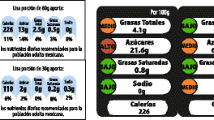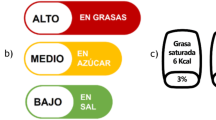Abstract
Objective
The purpose of this study was to assess the impact of four different front-of-package (FOP) labelling systems on consumer perception and purchasing intent of food, and whether these systems help consumers select a balanced pattern of eating.
Methods
The four FOP labelling systems studied included two nutrient-specific systems — the Traffic Light (TL) and the Guideline Daily Amount (GDA) — and two summary indicator systems — NuVal® and My-5®. Phase 1 was a small study with 36 participants to determine consumer understanding of the four FOP labelling systems and to inform the development of the questions for Phase 2, which consisted of a survey of 2,200 adults obtained through an online panel.
Results
Although the TL and GDA were rated similar to the Nutrition Facts table in terms of attributes, these FOP systems were considered more visually appealing. Consumers indicated that the numeric summary indicator systems did not provide sufficient information. Approximately half of the respondents indicated that the FOP systems would help them make healthier choices. However, due to the limitations of each, consumers often misinterpreted a food’s healthiness compared to their baseline perceptions. Similarly, consumers’ intent to purchase based on the FOP system did not show a consistent pattern.
Conclusion
Although well received by consumers, FOP labelling systems can lead to confusion depending on perceived understanding of the system used. The nutrient-specific systems tend to be preferred by most consumers; however, the overall impact on selecting healthier eating patterns has yet to be demonstrated.
Résumé
Objectif
Évaluer l’impact de quatre systèmes d’étiquetage de face sur les perceptions des consommateurs et sur leurs intentions d’acheter des aliments, et voir si ces systèmes aident les consommateurs à équilibrer leur alimentation.
Méthode
Les quatre systèmes d’étiquetage de face à l’étude incluaient deux systèmes portant spécifiquement sur les substances nutritives — celui des «feux de circulation» (FC) et celui des Repères nutritionnels journaliers (RNJ) — et deux systèmes d’indicateurs sommaires — NuVal® et My-5®. Au cours de la phase 1, nous avons mené une petite étude avec 36 participants pour déterminer la compréhension des quatre systèmes par les consommateurs et pour éclairer l’élaboration de questions en vue de la phase 2, laquelle a consisté en un sondage auprès de 2 200 adultes dans le cadre d’un panel en ligne.
Résultats
Bien que les attributs des systèmes FC et RNJ aient reçu des évaluations semblables à ceux du tableau «Valeur nutritive», ces systèmes d’étiquetage de face ont été jugés plus attrayants visuellement. Les consommateurs ont indiqué que les systèmes d’indicateurs sommaires numériques ne leur fournissaient pas assez d’information. Environ la moitié des répondants ont indiqué que les systèmes d’étiquetage de face les aideraient à faire des choix plus sains. Cependant, en raison des contraintes de chaque système, les consommateurs ont souvent mal interprété la qualité sanitaire d’un aliment comparativement à leurs perceptions de référence. De même, les intentions d’achat des consommateurs fondées sur les systèmes d’étiquetage de face n’ont pas affiché une structure cohérente.
Conclusion
Malgré le fait qu’ils sont bien accueillis par les consommateurs, les systèmes d’étiquetage de face peuvent prêter à confusion selon la compréhension perçue du système utilisé. La plupart des consommateurs ont tendance à préférer les systèmes portant spécifiquement sur les substances nutritives, mais l’impact global de ces systèmes sur la sélection de modes de consommation plus sains reste à prouver.
Similar content being viewed by others
References
Langlois K, Garriguet D, Findlay L. Diet composition and obesity among Canadian adults. Statistics Canada, Catalogue no. 82-003-XPE. Health Rep 2009;20(4):11–20.
Katzmarzyk PT, Reeder BA, Elliott S, Joffres MR, Pahwa P, Raine KD, et al. Body mass index and risk of cardiovascular disease, cancer and all-cause mortality. Can J Public Health 2012;103(2):147–51.
Cancer Care Ontario, Public Health Ontario. Taking Action to Prevent Chronic Disease: Recommendations for a Healthier Ontario, Technical Appendix. 2012. Available at: https://doi.org/www.oahpp.ca/takingaction/index.html (Accessed September 7, 2012).
Canadian Food Inspection Agency. Guide to Food Labelling and Advertising. Available at: https://doi.org/www.inspection.gc.ca/food/labelling/guide-to-food-labelling-and-advertising/eng/1300118951990/1300118996556 (Accessed September 7, 2012).
Health Canada. The Nutrition Facts Table. Available at: https://doi.org/www.hc-sc.gc.ca/fn-an/label-etiquet/nutrition/cons/index-eng.php (Accessed September 7, 2012).
Drenowski A, Maskowitz H, Reisner M, Krieger B. Testing consumer perception of nutrient content claims using conjoint analysis. Public Health Nutr 2010;13(5):688–94.
Food Standards Agency. Front-of-pack traffic light signpost labelling: Technical Guidance. Issue 2, November 2007. Available at: https://doi.org/www.food.gov.uk/multimedia/pdfs/frontofpackguidance2.pdf (Accessed September 7, 2012).
Katz DL, Njike VY, Rhee LQ, Reingold A, Ayoob KT. Performance characteristics of NuVal and the Overall Nutritional Quality Index (ONQI). Am J Clin Nutr 2010;91(Suppl):1102S–1108S.
Drewnowski A. The Nutrient Rich Foods Index helps to identify healthy, affordable foods. Am J Clin Nutr 2010;9(Suppl):1095S–1101S.
FoodDrinkEurope. GDAs—The facts. Your Choice. Available at: https://doi.org/www.gda.ciaa.eu/asp2/guideline-daily-amounts.asp (Accessed September 7, 2012)
Statistics Canada. Available at: https://doi.org/www.www12.statcan.ca/census-recensement/index-eng.cfm (Accessed September 7, 2012).
Wartella EA, Lichtenstein AH, Boon CS (Eds.), Committee on Examination of Front-of-Package Nutrition Rating Systems and Symbols Report. Front-of-package nutrition rating systems and symbols (Phase I). Washington, DC: Institute of Medicine, 2010.
NuVal LLC. NuVal 1-100: Nutrition made easy. Available at: https://doi.org/www.nuval.com/location (Accessed September 7, 2012).
Wartella EA, Lichtenstein AH, Yaktine A, Nathan R (Eds.), Committee on Examination of Front-of-Package Nutrition Rating Systems and Symbols (Phase II). Washington: Institute of Medicine, 2012.
Feunekes GIJ, Gortemaker IA, Willems AA, Lion R, vanden Kommer M. Front-of-pack nutrition labelling: Testing effectiveness of different nutrition labelling formats front-of-pack in four European countries. Appetite 2008;50:57-70.
Hersey JC, Wohlgenant KC, Arsenault JE, Kosa KM, Muth MK. Effects of front-of-package and shelf nutrition labelling systems on consumers. Nutr Rev 2013;71(1):1–14.
Health Canada. Eating Well with Canada’s Food Guide. Available at: https://doi.org/www.hc-sc.gc.ca/fn-an/food-guide-aliment/index-eng.php (Accessed September 7, 2012).
Grunert KG, Fernández-Celemín L, Wills JM, Storcksdieck Genannt Bonsmann S, Nureeva L. Use and understanding of nutrition information on food labels in six European countries. J Public Health 2010; DOI: 10.1007/s10389-009-0307-0.
Grunert KG, Wills JM, Fernández-Celemín L. Nutrition knowledge and use of understanding of nutrition information on food labels among consumers in the UK. Appetite 2010;55:177-89.
Hess R, Visschers VH, Siegrist M. The role of health-related, motivational and sociodemographic aspects in predicting food label use: A comprehensive study. Public Health Nutr 2012;15(3):407–14.
Steenhuis IH, Waterlander WE, de Mul A. Consumer food choices: The role of price and pricing strategies. Public Health Nutr 2011;14(12):2220–26.
Mozaffarian D, Afshin A, Benowitz NL, Bittner V, Daniels SR, Franch HA, et al. Population approaches to improve diet, physical activity, and smoking habits: A scientific statement from the American Heart Association. Circulation 2012;126(12):1514–63.
Author information
Authors and Affiliations
Corresponding author
Additional information
Acknowledgement of sources of support: The authors acknowledge the financial support of Canada Beef, the Canadian Pork Council, Dairy Farmers of Canada and Egg Farmers of Canada to conduct this research. Our thanks to David Ang from TNS Canada for technical expertise, and to Isabelle Neiderer from Dairy Farmers of Canada and Lynn Plunkett from Lynn Plunkett and Associates for the development of this project.
Conflict of Interest: None to declare.
Rights and permissions
About this article
Cite this article
Savoie, N., Barlow (Gale), K., Harvey, K.L. et al. Consumer Perceptions of Front-of-package Labelling Systems and Healthiness of Foods. Can J Public Health 104, e359–e363 (2013). https://doi.org/10.17269/cjph.104.4027
Received:
Accepted:
Published:
Issue Date:
DOI: https://doi.org/10.17269/cjph.104.4027




